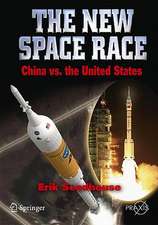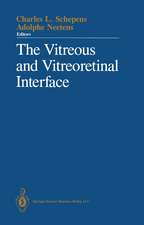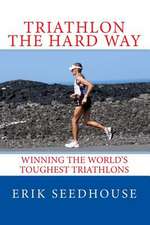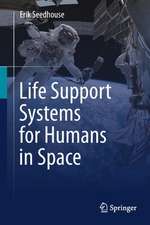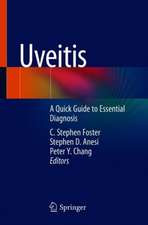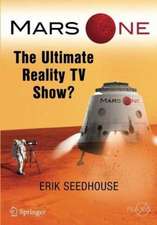Microgravity and Vision Impairments in Astronauts: SpringerBriefs in Space Development
Autor Erik Seedhouseen Limba Engleză Paperback – 25 sep 2015
Din seria SpringerBriefs in Space Development
-
 Preț: 262.68 lei
Preț: 262.68 lei -
 Preț: 379.09 lei
Preț: 379.09 lei -
 Preț: 378.12 lei
Preț: 378.12 lei -
 Preț: 379.09 lei
Preț: 379.09 lei -
 Preț: 380.07 lei
Preț: 380.07 lei -
 Preț: 477.72 lei
Preț: 477.72 lei -
 Preț: 474.84 lei
Preț: 474.84 lei - 15%
 Preț: 463.35 lei
Preț: 463.35 lei -
 Preț: 376.96 lei
Preț: 376.96 lei -
 Preț: 410.77 lei
Preț: 410.77 lei - 15%
 Preț: 463.35 lei
Preț: 463.35 lei -
 Preț: 410.39 lei
Preț: 410.39 lei - 15%
 Preț: 461.87 lei
Preț: 461.87 lei -
 Preț: 380.45 lei
Preț: 380.45 lei -
 Preț: 378.34 lei
Preț: 378.34 lei -
 Preț: 378.34 lei
Preț: 378.34 lei -
 Preț: 377.35 lei
Preț: 377.35 lei -
 Preț: 443.58 lei
Preț: 443.58 lei -
 Preț: 378.12 lei
Preț: 378.12 lei -
 Preț: 425.27 lei
Preț: 425.27 lei -
 Preț: 317.73 lei
Preț: 317.73 lei -
 Preț: 444.74 lei
Preț: 444.74 lei -
 Preț: 477.17 lei
Preț: 477.17 lei -
 Preț: 344.53 lei
Preț: 344.53 lei -
 Preț: 378.12 lei
Preț: 378.12 lei
Preț: 358.48 lei
Preț vechi: 377.35 lei
-5% Nou
Puncte Express: 538
Preț estimativ în valută:
68.59€ • 71.62$ • 56.77£
68.59€ • 71.62$ • 56.77£
Carte tipărită la comandă
Livrare economică 05-19 aprilie
Preluare comenzi: 021 569.72.76
Specificații
ISBN-13: 9783319178691
ISBN-10: 3319178695
Pagini: 90
Ilustrații: XII, 96 p. 49 illus., 46 illus. in color.
Dimensiuni: 155 x 235 x 8 mm
Greutate: 0.16 kg
Ediția:1st ed. 2015
Editura: Springer International Publishing
Colecția Springer
Seria SpringerBriefs in Space Development
Locul publicării:Cham, Switzerland
ISBN-10: 3319178695
Pagini: 90
Ilustrații: XII, 96 p. 49 illus., 46 illus. in color.
Dimensiuni: 155 x 235 x 8 mm
Greutate: 0.16 kg
Ediția:1st ed. 2015
Editura: Springer International Publishing
Colecția Springer
Seria SpringerBriefs in Space Development
Locul publicării:Cham, Switzerland
Public țintă
ResearchCuprins
Introduction.- Syndrome-specific Anatomy and Physiology.- Earth-bound Pathophysiology of Increased Intracranial Pressure.- Pathophysiology of Increased Intracranial Pressure in Weightlessness.- Pathology, demographics and anatomy of papilledema.- Microgravity Induced Cephalad Fluid Shift.- The Role of Carbon Dioxide.- Advanced Resistive Exercise Device (ARED).- Diet on board the International Space Station.
Notă biografică
Erik Seedhouse is a Norwegian-Canadian suborbital astronaut whose life-long ambition is to work in space. After completing a degree in Sports Science the author joined the 2nd Battalion the Parachute Regiment. During his time in the ‘Para’s’, Erik spent six months in Belize, where he was trained in the art of jungle warfare. Later, he spent several months learning the intricacies of desert warfare in Cyprus. He made 30+ jumps from a C130, performed 200+ helicopter abseils and fired more anti-tank weapons than he cares to remember!
Upon returning to the comparatively mundane world of academia, the author embarked upon a Master’s in Medical Science, supporting his studies by winning prize money in 100 kilometer running races. After placing third in the World 100km Championships in 1992, the author turned to ultra-distance triathlon, winning the World Endurance Triathlon Championships in 1995 and 1996. For good measure, he won the World Double Ironman Championships and the Decatriathlon, an event requiring competitors to swim 38km, cycle 1800km, and run 422km. Non-stop!
Returning to academia, Erik pursued his Ph.D. at the German Space Agency’s Institute for Space Medicine. While studying he won Ultraman Hawai’i and the European Ultraman Championships and completed Race Across America. As the world’s leading ultra-distance triathlete Erik was featured in dozens of magazines and television interviews. In 1997, GQ magazine nominated him as the ‘Fittest Man in the World’.
In 1999, Erik retired from triathlon. In 2005 he worked as an astronaut training consultant for Bigelow Aerospace and wrote ‘Tourists in Space’. He is a Fellow of the British Interplanetary Society and a member of the Space Medical Association. In 2009, he was one of the final 30 candidates in the Canadian Space Agency’s Astronaut Recruitment Campaign. Erik works as a spaceflight instructor for the American
Astronautics Institute, professional speaker, triathlon coach, author, and Editor-in-Chief for the Handbook of Life Support Systems for Spacecraft. Between 2008 and 2013 he served as director of Canada’s manned centrifuge operations.
In addition to being a suborbital astronaut, triathlete, centrifuge operator, pilot and author, Erik is an avid mountaineer and is pursuing his goal of climbing the Seven Summits. This brief is his eighteenth book. When not writing, he spends as much time as possible in Kona on the Big Island of Hawai’i and at his real home in Sandefjord, Norway. Erik and his wife, Doina, are owned by three rambunctious cats – Jasper, Mini-Mach and Lava.
Upon returning to the comparatively mundane world of academia, the author embarked upon a Master’s in Medical Science, supporting his studies by winning prize money in 100 kilometer running races. After placing third in the World 100km Championships in 1992, the author turned to ultra-distance triathlon, winning the World Endurance Triathlon Championships in 1995 and 1996. For good measure, he won the World Double Ironman Championships and the Decatriathlon, an event requiring competitors to swim 38km, cycle 1800km, and run 422km. Non-stop!
Returning to academia, Erik pursued his Ph.D. at the German Space Agency’s Institute for Space Medicine. While studying he won Ultraman Hawai’i and the European Ultraman Championships and completed Race Across America. As the world’s leading ultra-distance triathlete Erik was featured in dozens of magazines and television interviews. In 1997, GQ magazine nominated him as the ‘Fittest Man in the World’.
In 1999, Erik retired from triathlon. In 2005 he worked as an astronaut training consultant for Bigelow Aerospace and wrote ‘Tourists in Space’. He is a Fellow of the British Interplanetary Society and a member of the Space Medical Association. In 2009, he was one of the final 30 candidates in the Canadian Space Agency’s Astronaut Recruitment Campaign. Erik works as a spaceflight instructor for the American
Astronautics Institute, professional speaker, triathlon coach, author, and Editor-in-Chief for the Handbook of Life Support Systems for Spacecraft. Between 2008 and 2013 he served as director of Canada’s manned centrifuge operations.
In addition to being a suborbital astronaut, triathlete, centrifuge operator, pilot and author, Erik is an avid mountaineer and is pursuing his goal of climbing the Seven Summits. This brief is his eighteenth book. When not writing, he spends as much time as possible in Kona on the Big Island of Hawai’i and at his real home in Sandefjord, Norway. Erik and his wife, Doina, are owned by three rambunctious cats – Jasper, Mini-Mach and Lava.
Caracteristici
Explores the possible ophthalmic damage of long duration space flight in great detail and provides recommendations for mitigating the physiological impact on astronauts Includes supplementary material: sn.pub/extras




